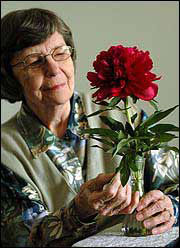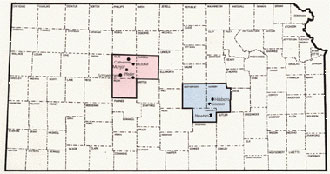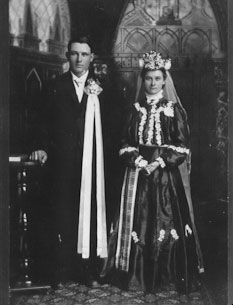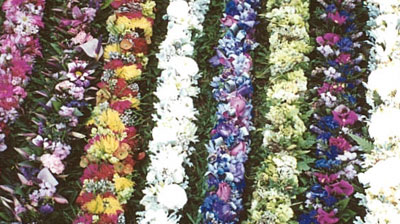Human Flower Project
Wednesday, May 04, 2005
Kansas Peonies—From Russia with Love
A purple heirloom passes over a continent, an ocean, to the American midwest and down the family line.
 Rachel Senner
Rachel Senner
with a Russian heirloom
Photo: Mike Yoder
The Lawrence Journal-World ran a feature story about 83-year-old Rachel Senner and the peonies her German-Russian ancestors brought to Kansas.
Senner’s family (we’re not given her maiden name) brought peony plants with them “when they immigrated to the United States from Russia in 1874, two years before Custer’s Last Stand. Her relatives were German Mennonites who also brought red wheat to Kansas.”
Russian peonies still bloom in Kansas wherever the Mennonites and their descendants settled, towns like “Newton, Hillsboro and Gossel.” Volga Germans, who were Lutherans and Catholics, also settled in Kansas. Rachel Senner lives in a nursing home in Lawrence now and no longer gardens, but last week her nephew from Topeka brought her a red-violet peony, the bloom from a plant she’d passed along to him.

Russian-German settlements in Kansas
Map: Kansas State Historical Society
German ancestors, from Russia? I found this element of the story confusing until learning that many Kansas settlers were in fact German pacifists who had immigrated to Russia in the 18th century to escape the draft and acquire their own land. A century later, when the Russian czar revoked the settlers’ military exemption, many families were attracted to Kansas, lured by land agents from the Kansas Pacific and Atchison, Topeka & Santa Fe railroads. The Kansas State Historical Society offers this excellent online exhibit of the Russian Germans.
 Joseph and Clementina Hertel, Ellis County, Kansas
Joseph and Clementina Hertel, Ellis County, Kansas
Photo: Kansas State Historical Society
“By 1879 about 12,000 Russian-Germans lived in the state. Russian-German farmers helped turn Kansas into the nation’s breadbasket. Unlike most other farmers new to Kansas, they were experienced at prairie-style agriculture. Mennonites often are credited with introducing Turkey red wheat to Kansas.” And peonies too.
Does anyone know if the Russian peonies of Kansas are Paeonia anomala? We understand that this variety originated in Western Russia but aren’t sure that Rachel Senner’s family flowers are of this type.
“The flower—it depends so much on people who have it, transmitting the story behind it to their children,” Senner said. That’s true. But the story—that is, the history of a people—“depends” on the flower also. A peony is proof there have been people with foresight. A peony in flower is incentive to learn who those people were.
Monday, May 02, 2005
The Lei Day Dilemma
May 1 is Lei Day in Hawaii, and May 2, those leis honor the Ali’is, or Hawaiian chiefs.

Lei Queen
Photo: City of Honolulu
Starting in 1927, May 1st was declared Lei Day in Hawaii, through the combined initiatives of a poet, a musician and a newspaper columnist. “The first celebration and exhibit of leis was at the Bank of Hawaii. In 1928, the first lei queen was Nina Bowman.” Like France’s muguet custom, here’s an example of popular culture glomming onto folkways—a process that, depending on your perspective, looks like cultural rescue or theft. Perhaps it’s only in the cultural sphere that these forces hula together.
Certainly Lei Day has become a flamboyant celebration, complete with beauty contests, lei-making competitions and exhibitions, and, more recently, heightened awareness of Hawaii’s dwindling species and vanishing floral habitat.
Kauai News reporter Dennis Fujimoto writes that commercial lei makers assert, ” ‘If I don’t pick ‘em, someone else will.’… This type of attitude would’ve earned a quick slap on the mouth from kupuna in other times, but in today’s society, it is accepted, with the result being the depletion of many of the lei materials growing in the forests.” The Kaua’i Museum presented its 25th Anniversary Award to Kirby Guyer for her lei made of backyard materials. Another prize went Jodi Gardner, for a garland woven with “the grass found growing near Nawiliwili Harbor” and agapanthus (blue lily) blooms: one part ecology, another part Martha Stewart DIY.
In lei day, we see culture’s choppy water—crosscurrents in the idea of preservation alone. How does one celebrate and sustain the islands’ custom of lei-making and protect the endemic flowers too? More on this topic at a later date—with insights, we hope, from you.

Leis from Honolulu’s contest
Photo: City of Honolulu
On May first, these beautiful garlands are the main attraction. May 2 is more ceremonial: “The contest leis will be taken to Mauna `Ala, the Royal Mausoleum at 2261 Nu`uanu Avenue,” starting at 9:00 a.m. The public will be invited to “drap(e) the leis on the crypts and tombs of our ali`i” (chieftains).
Maybe the ancestors will suggest a way out of Hawaii’s floral conundrum.
Culture & Society • Ecology • Religious Rituals • Secular Customs • Permalink




